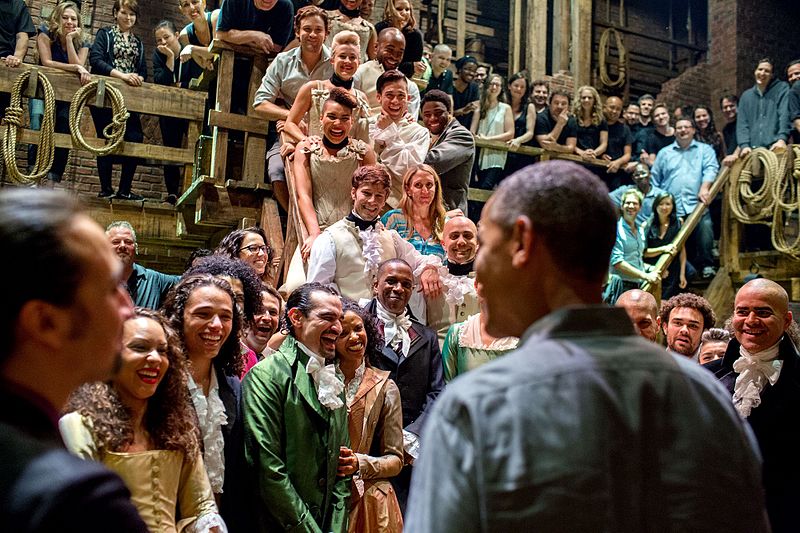Op-Ed: The case against colorblind casting
Photo credit: Pete Souza
Former president Barack Obama greets the racially diverse cast and crew of “Hamilton” after a performance. Though often praised for its portrayal of the founding fathers by diverse actors, “Hamilton” is not a product on colorblind casting, but rather casting that is color-conscious.
Growing up, I loved stories with elements of fantasy. I was completely enthralled by worlds that didn’t follow the rules and heroes that upheld my principles. However, I didn’t think I could be a catalyst for change in my own world because none of them looked like me. I didn’t have Hermione’s intriguing caramel-colored hair or Supergirl’s piercing blue eyes. Even when studios tried to inject diversity into the stories I loved, it felt forced, as though these characters were just westernized, palatable representations of their cultures.
Colorblind casting, a typical practice in Hollywood and on Broadway, happens when studios or producers cast characters without regard to their race. This is often used in previously created works by changing a character’s race without changing anything else about the character. New works can also be created without having specific races implied for the roles.
Many argue that very successful and progressive pieces of media have benefited from colorblind casting, citing Lin-Manuel Miranda‘s “Hamilton.” In this piece, the founding fathers are played by actors of various races. In the original cast, Alexander Hamilton was played by Miranda himself, who is of Puerto-Rican descent. Thomas Jefferson was played by African-American performer Daveed Diggs.
Though at first glance this casting might appear colorblind, Miranda and his colleagues purposefully chose non-white actors to send a message that an America without racism would have been an America with much more diverse founding fathers. There is also a sense of irony in the choice of a black man as renowned slave-owner Thomas Jefferson. It is also clear that this casting was not meant to be colorblind through “Hamilton”‘s controversial call for “non-white” actors.
Though the idea of colorblind casting is to eliminate cultural hegemony, it technically allows media’s shameful practice of “whitewashing”. Though this verb has many innocuous meanings, it also defines the action of casting a white actor in a role intended for a non-white performer.
From romantic comedy “Aloha,” in which a white actress portrayed an Asian female, to superhero blockbuster “Doctor Strange” which cast Tilda Swinton, a white woman, as an Asian man, whitewashing is incredibly common. CNN compiled a list of over 20 instances in the 2000s alone.
In an article for The Federalist, entrepreneur David Marcus made the case that whitewashing should not be seen as a flaw in works that do not want to comment on race relations.
“Ridley Scott’s use of white actors to play ancient Egyptians [in “Exodus: Gods and Kings”], especially Joel Edgerton as Pharaoh Ramesses II, caused consternation in cultural critics who saw it as a whitewashing,” Marcus wrote. “But Scott cast the actor he thought was best for the role in his script. If artists choose to focus on questions of race and privilege in their work, that’s their prerogative. But it’s not what Scott was doing. Scott was telling a seminal, ancient story told by people of every race across the globe. He has no responsibility to make it a statement on modern racial politics.”
However, race is a lens through which every human being sees the world. Unfortunately, race is integral to human identity and cannot simply be ignored in any work. A person’s race shapes how they see the world and how the world sees them. Acting as though race doesn’t exist and impact society eliminates something essential in storytelling: authenticity, as well as an ability for the consumer to see elements of their own world within others.
An example of colorblind casting in a classic or previously written work is Broadway’s “Mean Girls,” in which Gretchen was originally played by Asian-American actress Ashley Park. Part of the satirical narrative of “Mean Girls” is the title characters’ white privilege and the ways in which they stereotype students of color around them. Eliminating this element by casting the role of Gretchen without regard to her race eliminates this aspect of the story without adding any additional commentary on Gretchen’s Asian-American heritage.
To create a new character without any particular race in mind is to create a character without substance. Every real human being has a set of cultural experiences which they draw from and relate to when they deal with situations put before them. Put simply, creating characters without an implied race makes them unrealistic and also somewhat bland. In order to further discussions about race, the characters in movies in television need to have some sort of discussion about or connection to their culture.
Most importantly, colorblind casting promotes the problematic idea of claiming not to see color. Being “colorblind” suppresses cultural identity and ignores past injustices and struggles. As opposed to casting that is colorblind, directors and producers should consider casting that is color conscious. The way to truly achieve equality is to create a space for people to express different identities.
Playwrights, producers and casting directors of the next generation, I implore you to include diversity by acknowledging race rather than ignoring it.

Rio Hundley was involved in the Oracle from 2017-2021. She graduated in 2021. She was promoted to Sports Editor in 2019 and became Features Editor in 2020....











